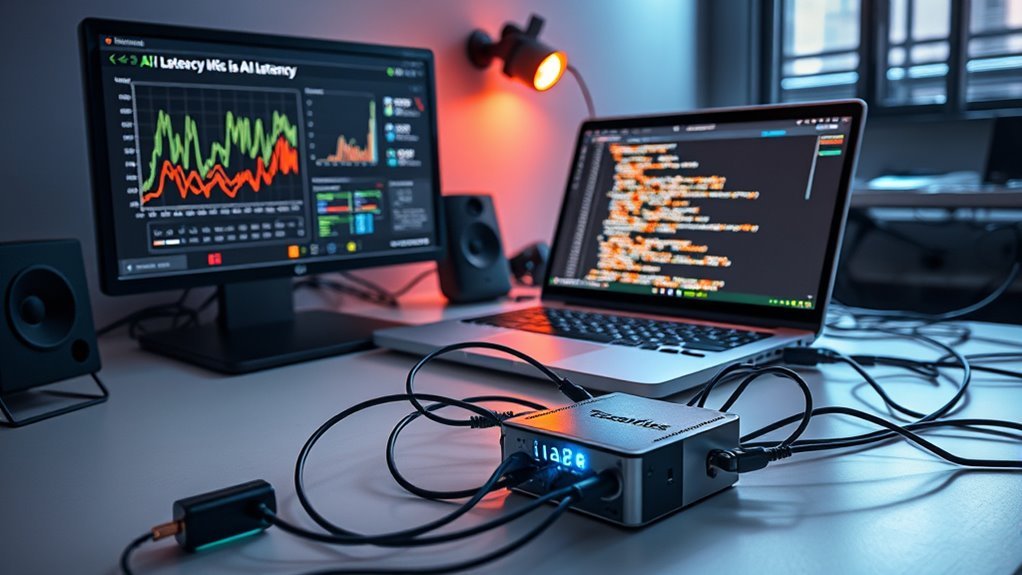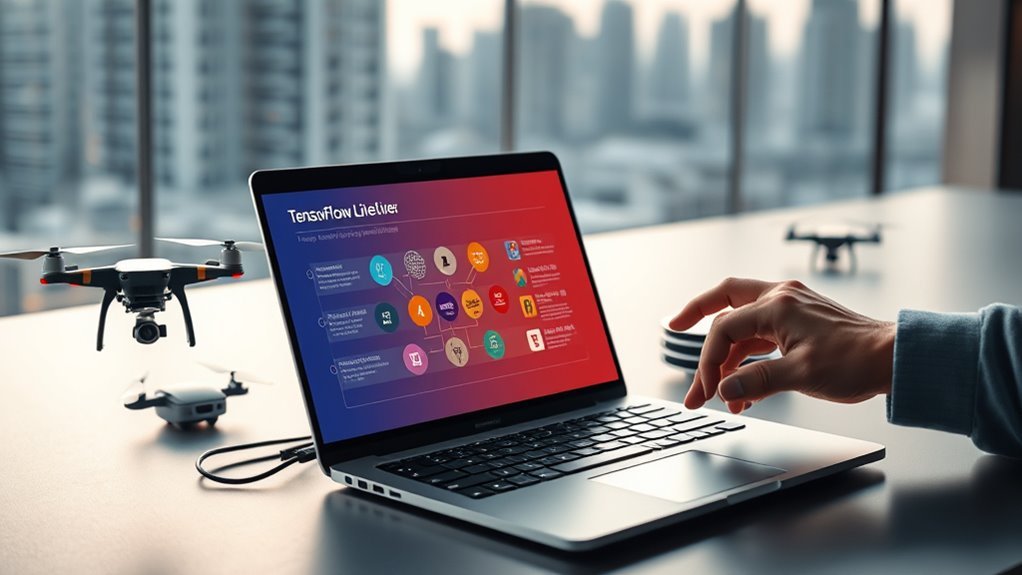You can optimize AI latency on edge devices by using frameworks like TensorFlow Lite, which supports real-time processing through efficient model compression, pruning, and quantization techniques. TensorFlow Lite’s modular architecture enables optimized inference by leveraging hardware accelerators such as GPUs and NPUs, minimizing delays. Efficient data preprocessing and operator fusion further reduce overhead. Implementing these strategies guarantees faster, low-latency AI inference at the edge, enhancing responsiveness. Explore additional methodologies to refine performance in constrained environments.
Understanding AI Latency and Its Impact

AI latency refers to the delay between input data reception and the system’s corresponding output or decision. You must understand this delay as a crucial AI performance metric that directly influences user experience and operational efficiency. Latency benchmarks help you gauge how swiftly your AI system responds under varying conditions, enabling precise comparisons across models and hardware configurations. By analyzing these metrics, you gain insight into bottlenecks limiting real-time responsiveness, which is essential for applications demanding immediate feedback. Achieving minimal latency grants you freedom from sluggish AI interactions, empowering decisions at the edge without reliance on distant cloud servers. Mastery over AI latency guarantees your system delivers timely, accurate outputs, preserving autonomy and performance integrity in mission-critical environments.
Benefits of Edge AI Frameworks for Latency Reduction

When you deploy AI models on edge devices, you gain the advantage of real-time processing, which considerably cuts down response times. This setup minimizes the need to transmit large amounts of data back and forth to central servers, reducing communication delays. As a result, you can achieve lower latency and more efficient AI inference in latency-sensitive applications.
Real-time Processing Advantages
Although processing data locally might seem resource-intensive, it greatly cuts down latency, allowing you to achieve near-instantaneous responses vital for real-time applications. With edge AI frameworks like TensorFlow Lite, you gain real time analytics and immediate feedback, empowering autonomous decision-making without cloud dependency. This autonomy is essential in scenarios demanding split-second accuracy.
| Advantage | Impact |
|---|---|
| Reduced Latency | Near-instant output generation |
| Real Time Analytics | Continuous, on-device data insights |
| Immediate Feedback | Rapid adaptive system responses |
| Enhanced Privacy | Data processed without cloud transfer |
Minimizing Data Transmission Delays
Since transmitting large volumes of data to cloud servers introduces significant delays, minimizing data transmission is crucial for latency-sensitive applications. By processing AI workloads on edge devices, you reduce the dependency on continuous data transfer. Implementing data compression techniques further decreases the payload size, cutting down transmission time without sacrificing critical information. Additionally, network optimization strategies, such as dynamic bandwidth allocation and protocol tuning, enhance the efficiency of the remaining data flow. Together, these approaches guarantee that you maintain control over latency constraints, enabling real-time responsiveness. Edge AI frameworks like TensorFlow Lite empower you to execute models locally, inherently minimizing data transmission delays and maximizing operational freedom. This autonomy is fundamental when low latency is non-negotiable for your AI-driven solutions.
Overview of TensorFlow Lite Architecture

You’ll want to understand TensorFlow Lite’s core components, including its interpreter, converter, and delegates, to effectively optimize AI latency. The architecture is designed to run compact models efficiently on edge devices by leveraging model quantization and pruning techniques. Grasping these elements helps you tailor models for faster inference without sacrificing accuracy.
Core Components Breakdown
Understanding TensorFlow Lite’s architecture is essential for optimizing AI latency at the edge. Its core components include the TensorFlow Lite interpreter, which executes optimized models, and the model file format designed for compactness. You’ll also find hardware delegates that enable framework integration with device-specific accelerators, reducing inference time considerably. The interpreter’s modular design lets you swap or extend delegates, giving you control over performance tuning. Additionally, the TensorFlow Lite runtime is lightweight, minimizing resource usage on edge devices. When you integrate these components, you create a streamlined pipeline from model loading to execution, maximizing throughput while minimizing latency. This architectural clarity empowers you to deploy AI models efficiently, maintaining flexibility without compromising speed or resource constraints.
Model Optimization Techniques
Optimizing AI latency goes beyond just knowing TensorFlow Lite’s architecture; it requires applying targeted model optimization techniques that reduce computational load and memory footprint. You’ll want to leverage model compression methods, which streamline your neural networks by quantizing weights and activations, effectively shrinking model size without significant accuracy loss. Layer pruning is another critical approach, where you selectively remove redundant or less significant neurons and connections to accelerate inference. These techniques directly decrease the number of operations and memory accesses during execution, enabling faster responses on edge devices. By integrating model compression and layer pruning within TensorFlow Lite’s conversion pipeline, you can deploy highly efficient models that maintain performance while minimizing latency, freeing the ability to run complex AI workloads smoothly in resource-constrained environments.
Techniques for Model Optimization in TensorFlow Lite
Although deploying AI models on edge devices demands careful resource management, TensorFlow Lite offers a suite of optimization techniques that help reduce model size and latency without greatly sacrificing accuracy. You can leverage model compression strategies, such as pruning and weight clustering, to eliminate redundant parameters, which markedly decreases the model’s footprint. However, you must carefully evaluate performance trade offs, as aggressive compression may degrade inference precision or increase computational complexity. TensorFlow Lite’s selective operator fusion further streamlines execution by combining compatible operations, minimizing memory access overhead. Additionally, you can optimize model architecture by simplifying layers or reducing input dimensionality, balancing complexity and expressiveness. These techniques empower you to tailor AI models that meet edge device constraints while preserving essential performance, granting you the freedom to deploy efficient, responsive applications. Furthermore, integrating edge AI frameworks with cloud-based platforms enables dynamic resource allocation and auto-scaling capabilities to enhance model responsiveness under varying workloads.
Quantization Methods to Enhance Inference Speed
When you deploy models on edge devices, quantization becomes a critical technique to boost inference speed by reducing numerical precision of weights and activations. By applying various quantization techniques, you achieve effective model compression, which decreases memory footprint and computation time without greatly sacrificing accuracy. The choice between post-training quantization and quantization-aware training depends on your accuracy requirements and resource constraints. Here’s a concise comparison:
| Quantization Technique | Key Benefit |
|---|---|
| Post-Training Quantization | Quick deployment, minimal effort |
| Quantization-Aware Training | Higher accuracy retention |
| Dynamic Range Quantization | Balanced speed and precision |
Leveraging these methods lets you fine-tune the trade-off between latency and accuracy, empowering you with flexibility to optimize AI inference on resource-limited edge platforms.
Leveraging Hardware Acceleration With Edge AI
Since edge devices often have limited computational resources, leveraging hardware acceleration is essential to achieve low-latency AI inference. To maximize performance during edge deployment, you must consider hardware compatibility carefully. Here’s how you can effectively leverage hardware acceleration:
- Identify compatible accelerators such as GPUs, NPUs, or DSPs integrated into your edge device to guarantee seamless integration with frameworks like TensorFlow Lite.
- Utilize vendor-specific APIs and drivers that optimize inference execution, reducing overhead and latency.
- Optimize your AI model to exploit parallel processing capabilities and specialized instruction sets of the target hardware.
Additionally, combining edge AI with cloud-based solutions can enhance scalability and provide seamless integration for complex AI workloads.
Strategies for Efficient Data Preprocessing on Edge Devices
Efficient data preprocessing is essential for minimizing latency and conserving resources on edge devices, where computational power and memory are limited. To optimize your data pipeline, you should streamline input transformations by selecting lightweight preprocessing tools that reduce computational overhead. Prioritize operations like normalization, resizing, and quantization early in the pipeline, ideally leveraging hardware-specific acceleration. Employ techniques such as fixed-point arithmetic and model-aware preprocessing to align with your AI framework’s requirements, minimizing runtime conversions. Additionally, batch processing inputs when feasible can amortize overhead costs. Keep your preprocessing modular and configurable to maintain flexibility without sacrificing speed. By designing a lean, optimized data pipeline, you guarantee that your edge AI model processes inputs swiftly, preserving both throughput and energy efficiency. This approach grants you the freedom to deploy sophisticated AI on constrained devices effectively. Leveraging adaptive scaling strategies can further optimize resource management and enhance processing efficiency on edge devices.
Case Studies Demonstrating Latency Improvements
Although optimizing latency on edge AI devices involves various strategies, real-world case studies provide the most concrete evidence of their impact. When you examine latency benchmarks from these case studies, you gain actionable insights into the efficacy of frameworks like TensorFlow Lite.
- A smart camera application reduced inference time by 40%, proving that model quantization can dramatically cut latency.
- An industrial IoT sensor network achieved a 30% improvement in response time by offloading preprocessing to edge devices.
- A voice recognition system demonstrated a 25% latency reduction through optimized data pipelines and model pruning.
These case studies empower you to understand how specific optimizations translate into measurable latency improvements, enabling you to make informed decisions to maximize performance on your edge AI deployments.
Best Practices for Deploying AI Models on Edge Devices
When deploying AI models on edge devices, you must carefully balance resource constraints with performance requirements to achieve ideal results. Start by optimizing your model through quantization and pruning to reduce size without sacrificing accuracy. Use frameworks like TensorFlow Lite that support efficient edge inference, enabling low-latency responses critical for real-time applications. Verify your model deployment pipeline includes thorough profiling to identify bottlenecks and adjust accordingly. Manage memory and power consumption proactively, as edge devices often have strict limitations. Incorporate hardware-specific accelerations when available, such as DSPs or NPUs, to maximize throughput. Finally, validate your deployed model rigorously under real-world conditions to guarantee robustness and reliability. By adhering to these best practices, you retain control over performance while leveraging the freedom inherent in edge AI solutions. Additionally, implementing effective session management strategies ensures consistent user experience even in resource-constrained edge environments.



